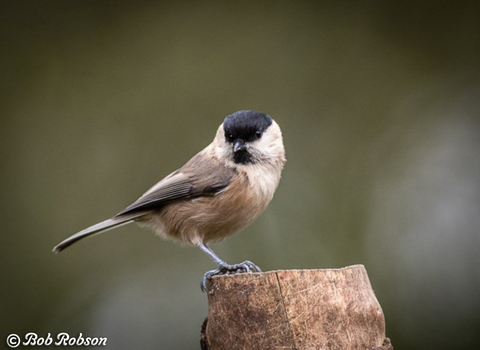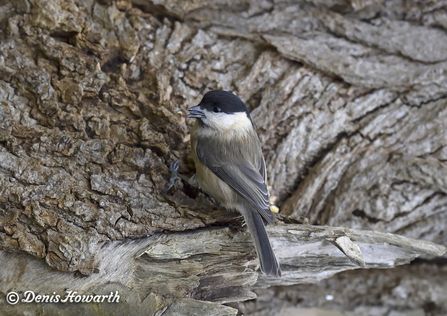
Willow tit
Photo by Bob Robson
Willow tit
The willow tit, Poecile montanus is a widespread species and a common breeding species in the right habitats throughout temperate and subarctic Europe and across the Palearctic.
In the UK it is found primarily in wet woodlands in early successional habitats along rivers or abandoned gravel pits. It is a Red list species due to recent declines.
As mentioned in the trail information the willow tit is very similar to the marsh tit which is also found at Low Barns. It is a medium sized tit, a little smaller than a great tit but larger than blue tit with a sooty brown cap to it’s head (not glossy black like the marsh tit), a black bib (smaller than the marsh tits) a grey brown back and a paler underside. On the wings is a pale wing bar, once thought to be diagnostic but has since also been seen in marsh tit. To cause an added challenge, when you watch them visiting the Low Barns bird feeding area at the west hide they tend to visit the bird tables flitting in and out very quickly making it difficult to decide which of the two species you just saw. Other than practice and time the best way to tell them apart is from the call. Click here.
Between 1995 and 2010 the population of this lovely bird fell by 79% across the UK with a 50% reduction in breeding territory. This species is now absent from much of the south east where it once bred and much of the west country. We are unsure exactly what has caused this decline but as is often the case it is likely to be a combination of factors.

Photo by Denis Howarth
The willow tits are not exactly at the top of the pecking order among birds. As they dig out their new nest holes each year they go about it very noisily, throwing sawdust everywhere and chattering between themselves and so can be very obvious to other birds. Great tits and blue tits can and do attack and remove them, taking over the nest themselves. In a study where 30 willow tit nests were watched only 10 were successful. 18 were taken over by bue tits and two by great tits. Both great tits and blue tits have increased in number in recent years adding to this pressure. Another bird which has increased dramatically in recent years (314 % between 1970 and 2016) and which is a nest predator of other hole nesting birds is the great spotted woodpecker. As willow tits have only one brood a year the loss of a brood is particularly devastating.
Though many other hole nesting birds benefit from bird boxes, willow tits prefer to dig out their own nests and so will rarely use boxes, giving them a further disadvantage. They are also quite specific about their prefered nesting habitat, favouring wet woodland with sufficient standing dead wood for nest building.
At Low Barns we are very proud to have this species along with the very similar marsh tit nesting here each year. The conservation team works hard to maintain ideal habitat for these species and many more so we hope you will enjoy watching them as much as we do.
